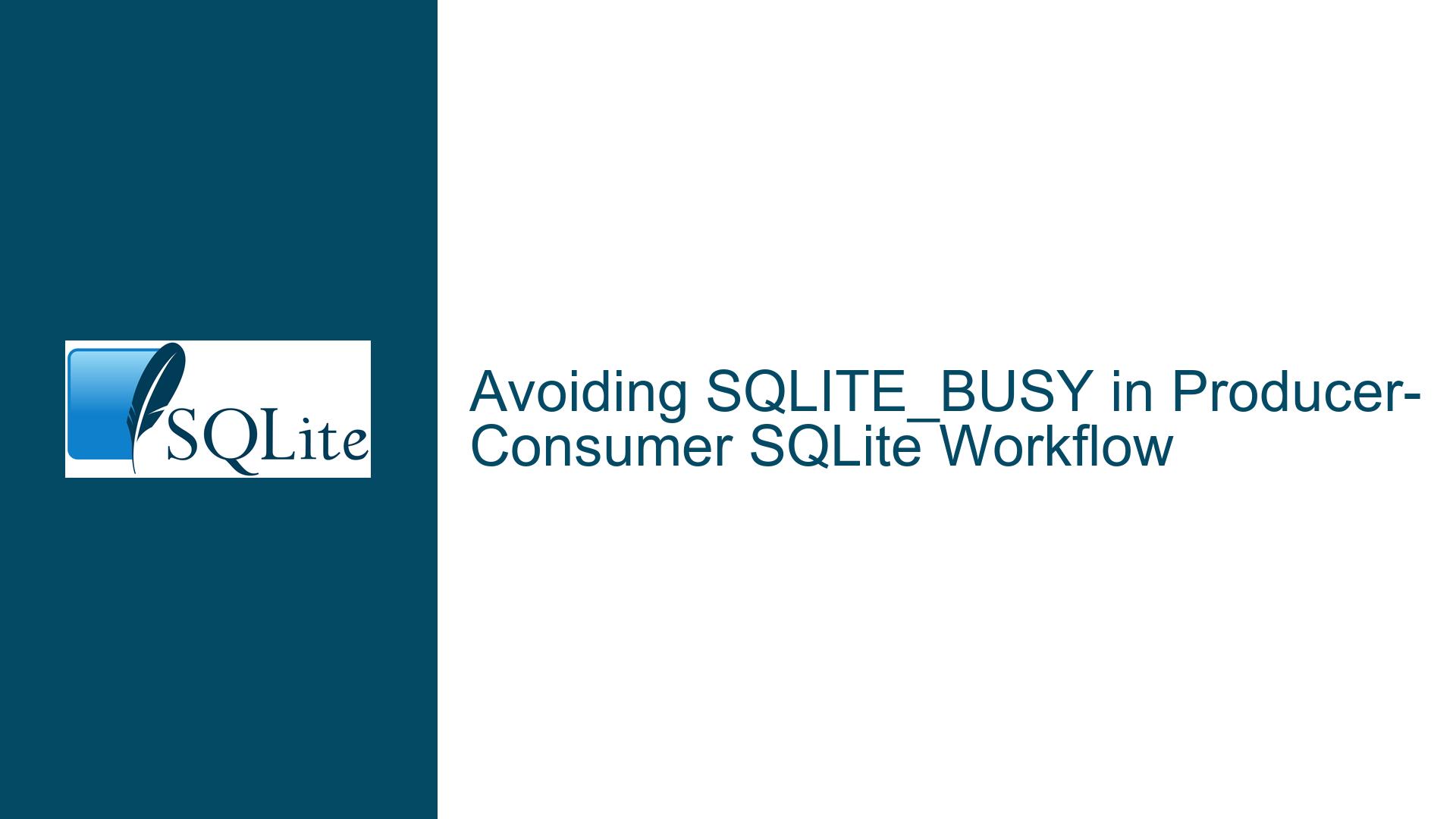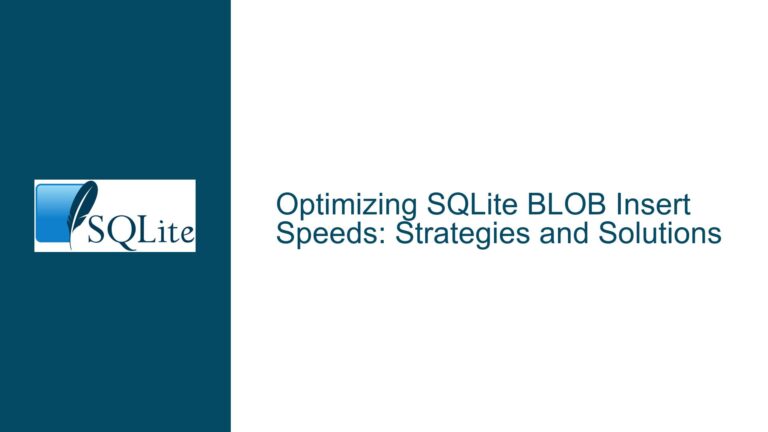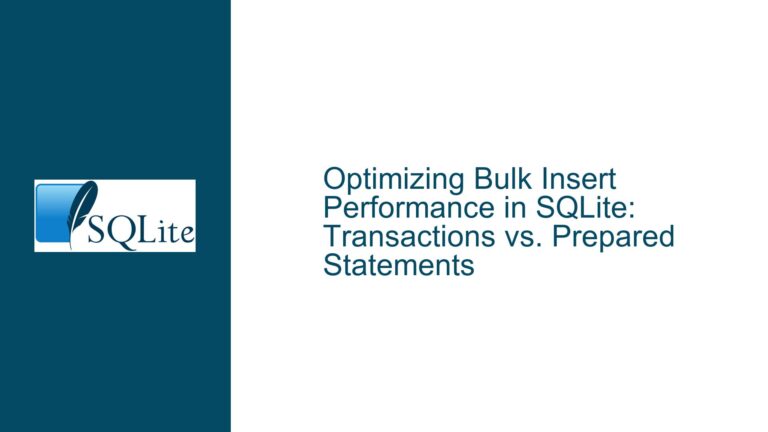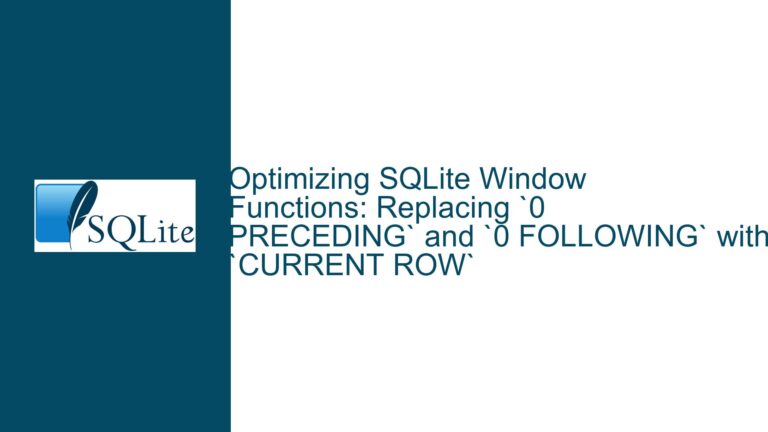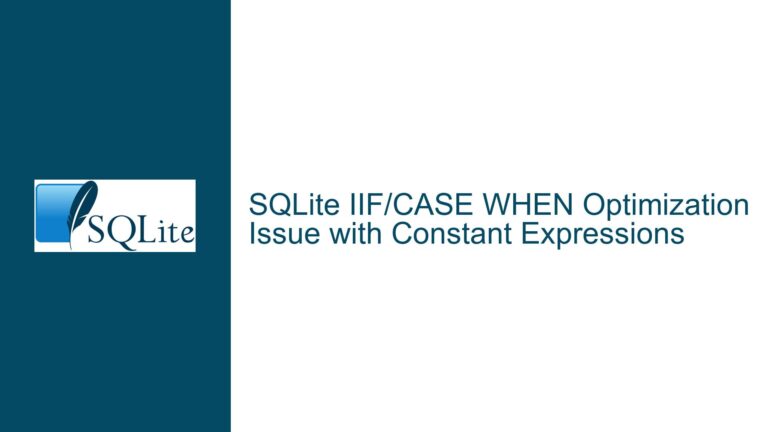Avoiding SQLITE_BUSY in Producer-Consumer SQLite Workflow
Issue Overview: SQLITE_BUSY in Concurrent Producer-Consumer Workflow
The core issue revolves around handling the SQLITE_BUSY error code in a concurrent producer-consumer workflow where SQLite is used as a structured logging tool. The producer process, implemented in C++, writes trace logs to the SQLite database, while the consumer process, implemented in C#, reads these logs to verify the correctness of the program under test. The SQLITE_BUSY error occurs when either the producer or the consumer process attempts to access the database while the other process holds a lock, preventing concurrent access. This error is particularly problematic because neither process currently handles it gracefully, leading to potential failures in the logging or verification mechanisms.
The producer process holds a database connection and transaction open continuously, committing and starting new transactions periodically. This approach was initially intended to optimize insert performance but has led to contention issues when the consumer process attempts to read the logs. The consumer process, on the other hand, reads the logs intermittently, but its access is blocked when the producer holds a write lock. The result is a deadlock-like scenario where both processes may end up waiting indefinitely for the other to release the lock.
The architectural question at hand is whether SQLite is suitable for this use case, given the high concurrency requirements and the need for low-latency logging. The producer process must never be blocked from inserting logs, as this could lead to timeouts in the serial communication processing. The consumer process, meanwhile, must be able to read the logs in a timely manner to ensure the program under test is functioning correctly. The current setup, which relies on SQLite’s default journaling mode, is causing contention issues that may not be easily resolved without significant changes to the architecture or the way SQLite is used.
Possible Causes: Contention in Default Journal Mode and Long-Held Transactions
The SQLITE_BUSY error is a direct consequence of SQLite’s default journaling mode, which enforces strict locking semantics to ensure data integrity. In this mode, writers block readers, and readers block writers, leading to contention when both processes attempt to access the database simultaneously. The producer process, which holds a long-lived transaction, exacerbates this issue by maintaining a write lock for extended periods, preventing the consumer process from accessing the database.
One of the primary causes of the SQLITE_BUSY error is the producer process’s strategy of holding a transaction open continuously. This approach was initially intended to optimize insert performance by batching multiple log entries into a single transaction. However, this optimization comes at the cost of increased contention, as the producer process holds a write lock for the duration of the transaction. This prevents the consumer process from reading the logs until the transaction is committed, leading to potential timeouts and failures in the verification process.
Another contributing factor is the lack of a busy handler in either process. A busy handler is a mechanism that allows SQLite to retry a failed operation for a specified period before returning the SQLITE_BUSY error. Without a busy handler, both processes immediately fail when they encounter a lock, leading to frequent errors and potential data loss. The absence of a busy handler is particularly problematic in a high-concurrency environment, where contention is expected and should be handled gracefully.
The use of SQLite’s default journaling mode also plays a significant role in the contention issues. In this mode, writers must obtain an exclusive lock on the database file before committing changes, which blocks all other readers and writers. This locking behavior is necessary to ensure data integrity but can lead to significant performance bottlenecks in a concurrent producer-consumer workflow. The consumer process, which reads the logs intermittently, is often blocked by the producer process’s write lock, leading to delays and potential timeouts.
Finally, the lack of coordination between the producer and consumer processes exacerbates the contention issues. While the producer process is designed to prioritize logging performance, it does not account for the needs of the consumer process, which requires timely access to the logs. This lack of coordination leads to frequent contention and SQLITE_BUSY errors, as both processes compete for access to the database without any mechanism to prioritize or schedule their operations.
Troubleshooting Steps, Solutions & Fixes: Implementing WAL Mode, Busy Handlers, and Transaction Optimization
To address the SQLITE_BUSY error and improve the performance of the producer-consumer workflow, several steps can be taken. These include enabling Write-Ahead Logging (WAL) mode, implementing busy handlers, optimizing transaction management, and coordinating access between the producer and consumer processes.
1. Enabling Write-Ahead Logging (WAL) Mode:
WAL mode is a significant improvement over the default journaling mode, as it allows readers and writers to access the database concurrently without blocking each other. In WAL mode, writers append changes to a separate WAL file, which readers can access without waiting for the writer to release its lock. This eliminates the contention issues caused by the default journaling mode and significantly reduces the likelihood of SQLITE_BUSY errors.
To enable WAL mode, execute the following SQL command on the database:
PRAGMA journal_mode=WAL;
Once WAL mode is enabled, it becomes a persistent attribute of the database file, meaning all subsequent connections will automatically use WAL mode. This ensures that both the producer and consumer processes benefit from the improved concurrency and reduced contention.
However, WAL mode is not without its drawbacks. One potential issue is the need for periodic checkpointing, where changes in the WAL file are written back to the main database file. If checkpointing is not performed regularly, the WAL file can grow indefinitely, leading to increased storage requirements and potential performance degradation. To mitigate this, SQLite provides the PRAGMA wal_autocheckpoint command, which automatically performs checkpointing when the WAL file reaches a specified size.
2. Implementing Busy Handlers:
Busy handlers are a crucial mechanism for handling contention in SQLite. A busy handler allows SQLite to retry a failed operation for a specified period before returning the SQLITE_BUSY error. This is particularly useful in a high-concurrency environment, where contention is expected and should be handled gracefully.
To implement a busy handler, use the sqlite3_busy_timeout function in C or the PRAGMA busy_timeout command in SQL. For example, to set a busy timeout of 500 milliseconds, execute the following SQL command:
PRAGMA busy_timeout=500;
This ensures that both the producer and consumer processes will retry their operations for up to 500 milliseconds before failing with a SQLITE_BUSY error. This reduces the likelihood of immediate failures and allows both processes to make progress even in the presence of contention.
3. Optimizing Transaction Management:
The producer process’s strategy of holding a long-lived transaction is a significant contributor to the contention issues. To reduce contention, the producer process should optimize its transaction management by committing transactions more frequently and keeping transactions as short as possible.
One approach is to batch log entries into smaller transactions, committing each batch after a specified number of entries or a time interval. For example, the producer process could commit a transaction after every 100 log entries or every second, whichever comes first. This reduces the duration of write locks and allows the consumer process to access the database more frequently.
Another approach is to use autocommit mode for individual log entries. In this mode, each log entry is inserted in its own transaction, which is automatically committed after the insert. While this approach may reduce insert performance due to the overhead of frequent commits, it significantly reduces contention and ensures that the consumer process can access the logs in a timely manner.
4. Coordinating Access Between Producer and Consumer Processes:
To further reduce contention, the producer and consumer processes should coordinate their access to the database. One approach is to use an interprocess communication (IPC) mechanism to signal when the producer process is about to commit a transaction, allowing the consumer process to delay its read operations until the commit is complete. This ensures that the consumer process does not attempt to read the database while the producer process holds a write lock, reducing the likelihood of SQLITE_BUSY errors.
Another approach is to implement a log spooler in the producer process, which buffers log entries in memory and writes them to the database in batches. This allows the producer process to continue logging without waiting for database I/O, while the consumer process can read the logs from the database without contention. The log spooler can be implemented as a background thread in the producer process, ensuring that logging operations do not block the main program under test.
5. Monitoring and Tuning Performance:
Finally, it is essential to monitor the performance of the producer-consumer workflow and tune the database configuration as needed. This includes monitoring the size of the WAL file, the frequency of checkpointing, and the duration of transactions. SQLite provides several pragmas and configuration options that can be used to optimize performance, such as PRAGMA cache_size to control the size of the in-memory page cache and PRAGMA synchronous to control the level of synchronization between writes and the underlying storage.
By implementing these steps, the producer-consumer workflow can achieve significant improvements in performance and reliability, reducing the likelihood of SQLITE_BUSY errors and ensuring that both processes can access the database without contention.
